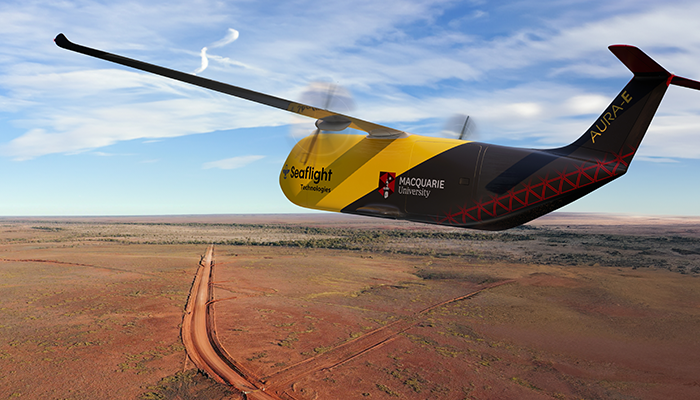Macquarie University’s Regional Drone Project Takes Flight with $1.48 Million Funding
The AURAE (Australian Ultra-efficient Regional Aircraft – Electric) project will cost $3 million (including in-kind support from a range of industry partners) and involves the design, construction and testing of a fully functioning demonstration model of Seaflight’s all-electric air cargo aircraft, incorporating the company’s advanced aerodynamic flow control technology.
Dr Sammy Diasinos, Senior Lecturer in Mechanical Engineering at Macquarie University says that regional and remote Australian communities will ultimately benefit from the project team’s plan to develop a commercial fixed-wing drone with significantly improved range and payload capabilities.
“This project will demonstrate a viable path to affordable, zero-emissions cargo delivery services that can be put in place across regional and remote Australia,” he says.
The prototype uncrewed aircraft system (UAS) will be designed to carry three full pallets of cargo over distances of up to 800km on pure battery power, based on a large fixed-wing platform with a remote pilot in the loop.
“This cargo drone’s range will be enough to connect almost any remote community in Australia to a regional hub for same-day delivery of essential goods,” Dr Diasinos says.
The partnership with Seaflight will allow the team to incorporate Seaflight’s clever aerodynamic flow control system.
This proprietary technology actively manipulates airflow over the wings so that the drone can gain high lift for short takeoffs and landings.
The technology simultaneously enables aircraft to be built with smaller, more efficient wings thus improving their range and carrying capacity due to reduced aerodynamic drag.
“The Seaflight system will allow the drone to operate from runways shorter than a cricket field, yet also cover the vast distances that define regional Australia,” Dr Diasinos says.
Macquarie University researchers will develop and optimise the aerodynamic flow control system, undertake performance modelling and powertrain testing, and analyse flight test data.
Undergraduate students will also have the opportunity to work on the project through paid summer internships.
Dr Graham Doig, Founder and CEO of Seaflight Technologies says, “With support from the US National Science Foundation and the Department of the Air Force, Seaflight developed this new form of active aerodynamic flow control to address the range and payload challenges that hold back electric flight in large countries like Australia. That’s why we are excited to partner with Macquarie University to demonstrate this revolutionary next step towards affordable regional cargo delivery that can serve even the most remote places”.
Assistant Minister for Regional Development and Education, Senator Anthony Chisholm says the project is part of the government’s commitment to partner with industry to develop innovative aviation technologies that can make a real difference for regional, rural and remote communities.
“This includes drones and remotely-piloted aircraft that will ensure remote communities get access to the health services they need, and the cargo makes its way onto the shelves at the local grocer.
“I’m looking forward to seeing the development of these projects get underway and the impact they will have in our regional, rural and remote communities, because when we invest in local innovation and manufacturing, it creates more opportunity for our regions now and into the future.”
Professor Lucy Marshall, Executive Dean of the Faculty of Science and Engineering at Macquarie University says, “This significant funding success reflects the world-class expertise in aerodynamics and engineering design at Macquarie University and our strong track record of partnering with industry to deliver cutting-edge research with real-world impact.
“We look forward to working with Seaflight Technologies to develop and demonstrate this exciting new technology, which has the potential to transform the way we transport goods to regional and remote parts of Australia in a sustainable way.”
The long-term goal is to translate the technology into a production drone that can provide fast, affordable and emissions-free delivery of critical supplies to regional communities, even during times of natural disaster that cut off other transport links.
The AURAE drone is expected to be built by the end of 2025 and ready for first flights in early 2026.

